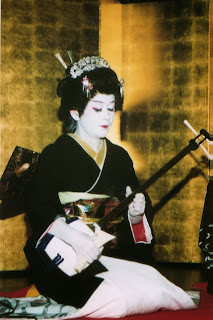 Music in Japan called ongaku, which when translated directly can be taken to mean as a voice for comfort. Although currently recognized by most of the outside world to pop, bubblegum type of songs, Japanese music is basically a combination of eclectic musical influences from all over the world. As much as it is steeped in tradition and local history, with the scale, but the style and borrowed instruments and loosely adapted from neighboring countries such as China, Korea and Indonesia, and has evolved to integrate Western musical styles such as jazz, rock, ska and reggae.
Music in Japan called ongaku, which when translated directly can be taken to mean as a voice for comfort. Although currently recognized by most of the outside world to pop, bubblegum type of songs, Japanese music is basically a combination of eclectic musical influences from all over the world. As much as it is steeped in tradition and local history, with the scale, but the style and borrowed instruments and loosely adapted from neighboring countries such as China, Korea and Indonesia, and has evolved to integrate Western musical styles such as jazz, rock, ska and reggae.The development of Japanese Music
Disc Jockey (DJ) and hip-hop music producers are very interested in the Japanese audio production late 1970s and early 1980s. Technics DJ 1200 is the best option, and the Roland TR-808 Rhythm Composer has a strong bass character. Anyway, symbolizing the electric dance music and hip-hop. In the last 20 years, the amount sold reached a record 10 times, with the price doubled. In essence, the phonograph has been regarded as a musical instrument, not just a tape recorder. DJ device is also made in Japan, both Technics and Vestax.
Variety Music Japan
There are two types of traditional Japanese music: the art of music and the music that is applied to the drama. Art music has several different styles, each of which is established separately in each period of Japanese history. In general, the Japanese prefer the vocal music of the instrument. In addition, traditional Japanese music are often developed as part of the drama as Noh, Kabukl, and Bunraku. Examples of some Japanese music is "Gagaku". Gagaku is music made in court, especially among the nobility and upper class ruling. Gagaku is classified into three types, namely the foreign original, the original Japanese and mix. In the development of gagaku used in contemporary music.
Japanese musical instrument
Most Japanese music genre is still much to use the shamisen, or three-friction instrument most commonly referred to as the Japanese guitars. In quota, or a short song usually sung by Geisha and nagauta or old songs as done in Japanese Kabuki and Noh theater, which provides the backbone for the shamisen instrumentation. An evolution of jiuta or understated, classic style of shamisen music and developed by Shirakawa Gunpachiro blind musician and Takahashi Chikuzan are Tsugaru-jamisen where there are more free and improvised flashy fingerwork on the instrument.
Another instrument most commonly used in Japan is music Taiko, or Japanese drum. Tap the instrument dates back as far as 6. and 7. Century, and during the war it was used primarily to keep the enemy at bay and to deliver orders to the fighters. Taiko which come in various sizes and are usually an integral part of the music ensembles especially during festivals.
Japanese traditional instruments such as the biwa, short-necked fretted lute; are ryuteki, flute made of bamboo and used in gagaku which is a style of music associated with the Japanese Imperial Court; are kokyu, string instrument played with a bow that has a shape, and a unique sound Japan does not like lying to the shamisen. Patterned kokyu even in non-traditional Japanese music genre as jazz and blues.
Developments in the late 19. And early 20th century opened the ears of the Japanese into new genres such as enka, Japanese versions of American country melodramatic ballads, pop or kayokyoku West. Kayokyoku later evolved into the Japanese pop or J-pop - a style that is more certain with Western influences. Rock and roll by sweeping all over the world in the 1960s and 1970s, J-rock or rock Japan that attacked the Japanese music scene as well.
No comments:
Post a Comment